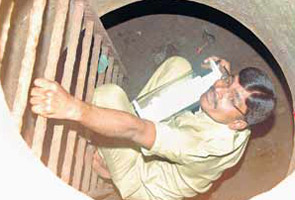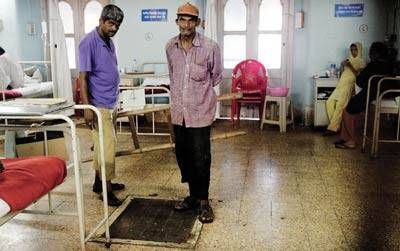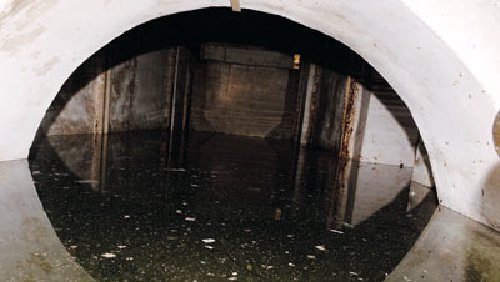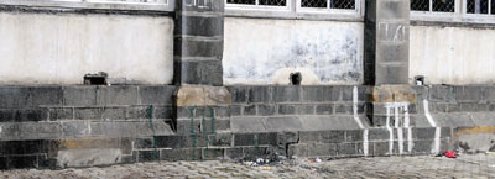Mirror reporters discover 18th century tunnel from St George’s Hospital that has exits at Gateway, Churchgate and Blue Gate
Lata Mishra and Sudhir Suryawanshi
Posted On Friday, June 18, 2010 at 04:31:42 AM
This is possibly Mumbai’s best-kept secret and most certainly the shortest shortcut to reach the Gateway, Churchgate or the Blue Gate from St George’s Hospital on P D’mello Road.
Two Mumbai Mirror reporters on Thursday discovered an over 240-year-old tunnel tucked under the St George’s Hospital.
The 1.5 km tunnel, now full of muck and sea water, starts under Ward 5 of the hospital and has exits at the Gateway, the Blue Gate and Churchgate.
1. PWD workers stand next to the trap door leading to the tunnel at St George’s Hospital at ward no 5 |
With its lone entrance, covered by a wooden hatch now, plonked right in the middle of the Swine Flu ward, the tunnel for many years has been a source of great curiosity and many unfounded stories in the hospital.
The wooden hatch on Thursday was raised and a ladder lowered into the tunnel to let the two reporters explore its depths. But they found that they could not go beyond a few metres.
The tunnel’s three arms lay blocked with brick-and-mud walls. There was knee deep water in the tunnel and hospital staff said the level would rise as monsoon progresses.
 |
|
Getting down the 1.5 Km Long tunnel at the Hospital
|
2. Mumbai Mirror reporter Sudhir Suryawanshi uses a ladder to get down to the 1.5-km long tunnel at the hospital |
Historians say since the Dutch, the French and the Portuguese posed a constant threat, the Britishers built a network of tunnels starting from St George’s Fort, present day’s St George’s Hospital.
These tunnels were used to ferry injured soldiers, arms and ammunitions and also as escape routes in event of an attack.
Urban historian Sharada Dwivedi said she had come across the St George’s Hospital tunnel during her research on Mumbai’s past. “There are many tunnels from the British period which run through the Fort area.
St George’s Hospital tunnel, the exit points of which are Churchgate, Gateway and Blue Gate |
The St George’s hospital tunnel may be connected to Apollo Bunder (Gateway of India), Churchgate and Blue Gate. These secret passageways tell us a lot about our past and they need to be protected and preserved,” she said.
The tunnel has tiny skylights that also let some fresh air in, not enough though. The tunnel smells of rotten flesh, enough to make anybody sick in a matter of minutes.
Former superintendent of St George’s Hospital, Dr K N Varade, said he got the tunnel door opened once during his tenure.
“The wooden plank covering the tunnel’s opening was damaged. I got it fixed. We did not talk about the tunnel because we didn’t want the Archaeological Survey of India to step in and take over this part of the hospital,” he said.
 |
|
The 18th century tunnel below the ward has law arched ceilings with barely enough room for an adult to stand erect
|
3. The 18th century tunnel below the ward has law
arched ceilings with barely enough room for an adult to stand erect
THE TUNNEL SHOULD BE PROPERLY MAPPED OUT TO PREVENT:_
[1] FUTURE CAVE INS
[2]DANGER TO BUILDINGS OLD AND NEW AND ITS PILINGS
[3] TO PREVENT IT BEING USED BY DRUG ADDICTS,CRIMINALS,TERRORISTS,NAXALS ETC ETC
[4] DUE TO RISING TEMPERATURES AND RISING SEA LEVELS ;THESE TUNNELS WILL BE A DANGER WHEN SEA WATER RUSHES IN DUE TO HIGH TIDES
[4] DUE TO RISING TEMPERATURES AND RISING SEA LEVELS ;THESE TUNNELS WILL BE A DANGER WHEN SEA WATER RUSHES IN DUE TO HIGH TIDES
===============================================================================================================
Tunnel below GPO is a 100-yr-old water harvesting system
Posted On Thursday, June 14, 2012 at 11:31:56 AM
Team from ASI and Pune institute discovers that ducts below the heritage monument lead to a reservoir; GPO plans to revive it
A water duct at the General Post Office (GPO) building, thought until now to be a storm water disposal unit, is actually a rain water harvesting unit. And the system, if the GPO has it way, will be restored to it original function by next year.
The ducts at the nearly century-old structure were discovered below the garden in 2010. However, their true function was discovered post a joint study by the Archaeological Survey of India (ASI) and Pune’s Deccan College Post Graduate and Research Institute, which is the largest institute on heritage archaelogy in Asia.
The team from ASI - Nilesh Jadhav and Mayur Thakare - worked along with Vasant Shinde, the joint director of the Pune institute. The discovery was made on Wednesday and the team will file a detailed report soon.
Speaking about GPO’s rain-water harvesting system Shinde said, “There is one reservoir with four ducts. Its dimensions are 50x50m and the depth is about 7 feet. There is a 5ft accumulation of silt in the structure which made me deduce that it had earlier been used as a rain water harvesting unit.”
Shinde added that a similar rain-water harvesting unit, which was over 3,500 years old, was discovered at Inamgaon in Pune district, close to Shirur.
The team said that the Britishers constructed such rain-water harvesting units not only to make maximum use of rain but also to prevent flooding in low-lying areas.
During the monsoon, Shinde added, when the reservoir fills up, excess water gets filtered out through outlets located on the walls. The structure is made of stone fitted in grooves to avoid any leakage, making it environment-friendly.
Director of Postal Services, (HQ) Abha Singh said, “We have asked for an estimate of the cost needed to revive the unit. We have to send it to our Delhi office for approval. We hope that the inauguration of the revived model will coincide with our centenary celebration next year. We also plan to release a commemorative stamp of GPO along with this revived model depending on approvals.”
Shinde added that he believes that such water harvesting units exist underneath all the heritage structures in the vicinity, including the Chhatrapati Shivaji Terminus (CST)
The PRO of Central Railways A K Singh said the Railways would be very interested in exploring the possibility. “Currently we use 19 lakh litres of potable water daily, of which one lakh is recycled and used to clean compartments and rakes. Such a harvesting method, if successfully adopted, could benefit us greatly.”
The ducts at the nearly century-old structure were discovered below the garden in 2010. However, their true function was discovered post a joint study by the Archaeological Survey of India (ASI) and Pune’s Deccan College Post Graduate and Research Institute, which is the largest institute on heritage archaelogy in Asia.
The team from ASI - Nilesh Jadhav and Mayur Thakare - worked along with Vasant Shinde, the joint director of the Pune institute. The discovery was made on Wednesday and the team will file a detailed report soon.
Speaking about GPO’s rain-water harvesting system Shinde said, “There is one reservoir with four ducts. Its dimensions are 50x50m and the depth is about 7 feet. There is a 5ft accumulation of silt in the structure which made me deduce that it had earlier been used as a rain water harvesting unit.”
Shinde added that a similar rain-water harvesting unit, which was over 3,500 years old, was discovered at Inamgaon in Pune district, close to Shirur.
The team said that the Britishers constructed such rain-water harvesting units not only to make maximum use of rain but also to prevent flooding in low-lying areas.
During the monsoon, Shinde added, when the reservoir fills up, excess water gets filtered out through outlets located on the walls. The structure is made of stone fitted in grooves to avoid any leakage, making it environment-friendly.
Director of Postal Services, (HQ) Abha Singh said, “We have asked for an estimate of the cost needed to revive the unit. We have to send it to our Delhi office for approval. We hope that the inauguration of the revived model will coincide with our centenary celebration next year. We also plan to release a commemorative stamp of GPO along with this revived model depending on approvals.”
Shinde added that he believes that such water harvesting units exist underneath all the heritage structures in the vicinity, including the Chhatrapati Shivaji Terminus (CST)
The PRO of Central Railways A K Singh said the Railways would be very interested in exploring the possibility. “Currently we use 19 lakh litres of potable water daily, of which one lakh is recycled and used to clean compartments and rakes. Such a harvesting method, if successfully adopted, could benefit us greatly.”



No comments:
Post a Comment